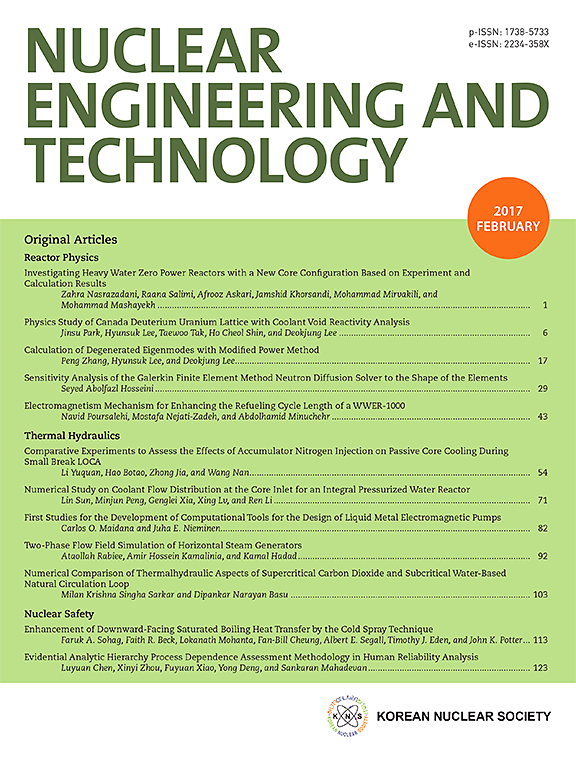基于铀矿厂尾矿中核同位素比率的制粉设施概念保障方法提案
IF 2.6
3区 工程技术
Q1 NUCLEAR SCIENCE & TECHNOLOGY
引用次数: 0
摘要
有一种观点认为,《全面保障监督协定》(CSA)应适用于作为核燃料循环第一阶段的制粉过程,以减少核扩散的可能性。因此,本研究旨在提出适用于制粉设施的新概念保障措施,并为其应用设计核材料衡算。制粉尾矿会达到一个世俗平衡状态。在接近这一平衡状态时,每种同位素的比例都会发生变化。首先,利用贝特曼方程分析这一现象,并评估利用特定同位素比值追踪未申报核活动的可行性。其次,利用蒙特卡洛 N 粒子代码对选矿厂尾矿进行伽马能谱分析,以验证未申报的核活动。这项研究表明,铀 235/Th 234 和铀 235/Pa 234m 的比值可以估算出一年内的生产时间。此外,对选矿厂尾矿的伽马能谱分析显示,由于 Th-234 的衰变,低能区存在明显差异。最后,为应用 CSA 设计了制粉设施的概念性物料平衡区、关键测量点和物料平衡期。预计将 CSA 应用于制粉设施不仅能加强核燃料循环,还能加强核不扩散系统。本文章由计算机程序翻译,如有差异,请以英文原文为准。
Conceptual safeguards method proposal for milling facilities based on nuclear isotopic ratios in uranium mill tailings
There is an argument that the Comprehensive Safeguards Agreement (CSA) should be applied to the milling process, which is the first stage of nuclear fuel cycle, to reduce the possibility of nuclear proliferation. Therefore, this study aims to propose new and conceptual safeguards applicable to milling facilities and design Nuclear Material Accountancy for its application. Mill tailings reach a secular equilibrium state. While approaching this equilibrium state, the ratio of each isotope changes. First, the Bateman equation was used to analyze this phenomenon and evaluate the feasibility of utilizing the specific isotope ratio to track undeclared nuclear activities. Second, the gamma spectrum analysis of mill tailings was conducted using the Monte Carlo N-Particle Code to validate undeclared nuclear activities. This study shows that the ratio of U-235/Th-234 and U-235/Pa-234m can estimate the production time within a year. Furthermore, gamma spectrum analysis of mill tailings revealed visible differences in the low-energy region due to the decay of Th-234. Finally, a conceptual Material Balance Area, Key Measurement Points, and Material Balance Period for milling facilities were designed to apply CSA. It is anticipated that applying CSA to milling facilities could enhance not only the nuclear fuel cycles but also nuclear non-proliferation system.
求助全文
通过发布文献求助,成功后即可免费获取论文全文。
去求助
来源期刊

Nuclear Engineering and Technology
工程技术-核科学技术
CiteScore
4.80
自引率
7.40%
发文量
431
审稿时长
3.5 months
期刊介绍:
Nuclear Engineering and Technology (NET), an international journal of the Korean Nuclear Society (KNS), publishes peer-reviewed papers on original research, ideas and developments in all areas of the field of nuclear science and technology. NET bimonthly publishes original articles, reviews, and technical notes. The journal is listed in the Science Citation Index Expanded (SCIE) of Thomson Reuters.
NET covers all fields for peaceful utilization of nuclear energy and radiation as follows:
1) Reactor Physics
2) Thermal Hydraulics
3) Nuclear Safety
4) Nuclear I&C
5) Nuclear Physics, Fusion, and Laser Technology
6) Nuclear Fuel Cycle and Radioactive Waste Management
7) Nuclear Fuel and Reactor Materials
8) Radiation Application
9) Radiation Protection
10) Nuclear Structural Analysis and Plant Management & Maintenance
11) Nuclear Policy, Economics, and Human Resource Development
 求助内容:
求助内容: 应助结果提醒方式:
应助结果提醒方式:


